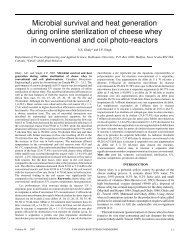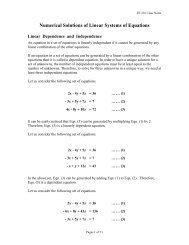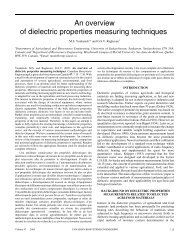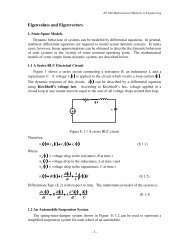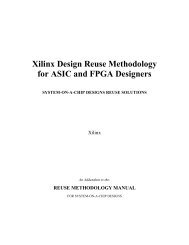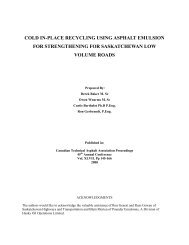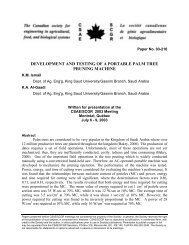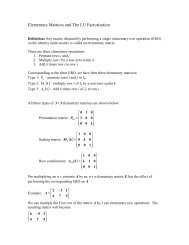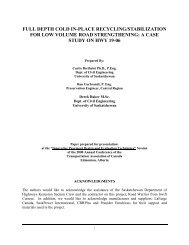Germination of wheat grains from uneven microwave heating in an ...
Germination of wheat grains from uneven microwave heating in an ...
Germination of wheat grains from uneven microwave heating in an ...
Create successful ePaper yourself
Turn your PDF publications into a flip-book with our unique Google optimized e-Paper software.
Fig. 1. Experimental setup. 1 - gra<strong>in</strong> <strong>in</strong>let, 2 - control<br />
p<strong>an</strong>el, 3 - <strong>microwave</strong> chamber, 4 - conveyor,<br />
5 - thermal camera, 6 - data acquisition system<br />
It is difficult to determ<strong>in</strong>e the suitability <strong>of</strong> a <strong>microwave</strong><br />
system for a particular application <strong>in</strong> the gra<strong>in</strong> <strong>in</strong>dustry due to<br />
other quality deteriorations. Non-uniformity <strong>of</strong> <strong>heat<strong>in</strong>g</strong> dur<strong>in</strong>g<br />
<strong>microwave</strong> treatment produces hot spots (localized elevated<br />
temperature), <strong>an</strong>d this may be one <strong>of</strong> the import<strong>an</strong>t factors for<br />
the quality deterioration <strong>of</strong> <strong>gra<strong>in</strong>s</strong>. The non-uniformity (∆T, the<br />
difference between maximum <strong>an</strong>d m<strong>in</strong>imum temperatures) <strong>of</strong><br />
surface temperatures <strong>of</strong> <strong>wheat</strong> (50 g samples) after <strong>microwave</strong><br />
treatment was found to be <strong>in</strong> the r<strong>an</strong>ge <strong>of</strong> 62.9 to 69.5 o C after<br />
expos<strong>in</strong>g to 500 W for 56 s (M<strong>an</strong>ickavasag<strong>an</strong> et al. 2006). Study<br />
on quality <strong>of</strong> the gra<strong>in</strong> samples <strong>in</strong> the hot-spot <strong>an</strong>d the normal<br />
<strong>heat<strong>in</strong>g</strong> zones after <strong>microwave</strong> treatment would help to<br />
underst<strong>an</strong>d the thermal degradation <strong>of</strong> bulk gra<strong>in</strong> dur<strong>in</strong>g<br />
<strong>microwave</strong> treatment. The objective <strong>of</strong> this research was to<br />
determ<strong>in</strong>e the germ<strong>in</strong>ation percentage for <strong>wheat</strong> samples<br />
collected <strong>from</strong> the hot-spot <strong>an</strong>d normal <strong>heat<strong>in</strong>g</strong> zones <strong>of</strong> bulk<br />
gra<strong>in</strong> after <strong>microwave</strong> treatment.<br />
MATERIALS <strong>an</strong>d METHODS<br />
Microwave treatment<br />
A laboratory scale, cont<strong>in</strong>uous type, <strong>in</strong>dustrial <strong>microwave</strong> dryer<br />
(2450 MHz) operated at 230 VAC, 60 Hz, 23 A (Model No:<br />
P24YKA03, Industrial Microwave Systems, Morrisville, NC)<br />
was used <strong>in</strong> this study. The <strong>microwave</strong> dryer consisted <strong>of</strong> a<br />
conveyer-belt assembly, <strong>microwave</strong> applicator, f<strong>an</strong>, <strong>an</strong>d a<br />
control p<strong>an</strong>el (Fig. 1). The speed <strong>of</strong> the conveyor <strong>an</strong>d the power<br />
output <strong>of</strong> the <strong>microwave</strong> generator could be adjusted to the<br />
desired level. The f<strong>an</strong> was on at all times dur<strong>in</strong>g the experiments<br />
<strong>an</strong>d the air <strong>in</strong>let temperature was set at 30 o C.<br />
C<strong>an</strong>adi<strong>an</strong> hard red spr<strong>in</strong>g <strong>wheat</strong> (obta<strong>in</strong>ed <strong>from</strong> the Cereal<br />
Research Centre, Agriculture <strong>an</strong>d Agri-Food C<strong>an</strong>ada, W<strong>in</strong>nipeg,<br />
M<strong>an</strong>itoba) was conditioned to four different moisture levels (12,<br />
15, 18, <strong>an</strong>d 21% wet basis) <strong>an</strong>d used <strong>in</strong> this study. In each<br />
experiment, a 50 g sample was spread on the conveyor <strong>an</strong>d the<br />
top surface was made flat. Then the gra<strong>in</strong> was allowed to enter<br />
the chamber where it was subjected to <strong>microwave</strong> treatment.<br />
The approximate volume <strong>of</strong> the gra<strong>in</strong> sample on the conveyor<br />
Fig. 2. Typical thermogram <strong>of</strong> <strong>wheat</strong> sample show<strong>in</strong>g hot<br />
spot after <strong>microwave</strong> treatment.<br />
dur<strong>in</strong>g treatment was 300×30×10 mm (length <strong>of</strong> the belt × width<br />
<strong>of</strong> the belt × depth <strong>of</strong> gra<strong>in</strong> on the belt). Two <strong>microwave</strong><br />
exposure times were achieved by ch<strong>an</strong>g<strong>in</strong>g the speed <strong>of</strong> the<br />
conveyor. Microwave treatment was given at five power levels<br />
(100, 200, 300, 400, <strong>an</strong>d 500 W) <strong>an</strong>d two exposure times (28<br />
<strong>an</strong>d 56 s). A thermal camera (Model: ThermaCAM TM SC500,<br />
spectral r<strong>an</strong>ge: 7.5 to 13.0 µm, FLIR Systems, Burl<strong>in</strong>gton, ON)<br />
was set to view the gra<strong>in</strong> sample on the conveyor as soon as it<br />
came out <strong>from</strong> the <strong>microwave</strong> chamber after treatment <strong>in</strong> order<br />
to sample <strong>from</strong> the hot-spot <strong>an</strong>d normal <strong>heat<strong>in</strong>g</strong> zones. Samples<br />
were collected us<strong>in</strong>g a spoon while view<strong>in</strong>g the live thermal<br />
images on the monitor <strong>of</strong> the data acquisition computer <strong>an</strong>d the<br />
gra<strong>in</strong> samples were stored <strong>in</strong> polyethylene bags separately for<br />
further <strong>an</strong>alysis. The f<strong>in</strong>al moisture content after <strong>microwave</strong><br />
treatment was measured for the <strong>wheat</strong> samples (bulk).<br />
Thermal imag<strong>in</strong>g<br />
In thermal imag<strong>in</strong>g, radiation pattern <strong>of</strong> <strong>an</strong> object (temperature)<br />
is converted <strong>in</strong>to a visible image. The color <strong>of</strong> each pixel <strong>in</strong> a<br />
thermal image represents a temperature value which is given on<br />
the temperature scale (right side <strong>of</strong> Fig. 2). Generally, <strong>in</strong> a<br />
thermal image, bright <strong>an</strong>d dark colors represent high <strong>an</strong>d low<br />
temperatures, respectively. Because <strong>of</strong> non-uniform <strong>heat<strong>in</strong>g</strong>, hot<br />
spots were observed (as patches) at one or two locations on the<br />
surface <strong>of</strong> <strong>wheat</strong> samples after <strong>microwave</strong> treatment. Samples<br />
were collected <strong>from</strong> the hot spot <strong>an</strong>d the rema<strong>in</strong><strong>in</strong>g region, <strong>an</strong>d<br />
subjected to a germ<strong>in</strong>ation test.<br />
<strong>Germ<strong>in</strong>ation</strong> test<br />
The germ<strong>in</strong>ation test was conducted for the samples collected<br />
<strong>from</strong> the hot-spot <strong>an</strong>d normal <strong>heat<strong>in</strong>g</strong> zones. It was not possible<br />
to conduct bak<strong>in</strong>g quality tests s<strong>in</strong>ce the qu<strong>an</strong>tity <strong>of</strong> sample<br />
collected <strong>from</strong> the hot spot was small (about 10 to 15 g <strong>from</strong><br />
50 g <strong>of</strong> the <strong>microwave</strong>-treated sample). However, to detect<br />
quality degradation <strong>of</strong> gra<strong>in</strong> due to high temperature, a<br />
germ<strong>in</strong>ation test c<strong>an</strong> be used because it is a sensitive, simple,<br />
<strong>an</strong>d reproducible test <strong>an</strong>d the results are reasonably correlated<br />
with bak<strong>in</strong>g tests (Ghaly <strong>an</strong>d Taylor 1982).<br />
Wheat kernels (25 seeds) were placed on Whatm<strong>an</strong> no. 3<br />
filter paper <strong>in</strong> a 90-mm diameter Petri-dish saturated with<br />
5.5 mL <strong>of</strong> distilled water. The Petri-dishes were covered with a<br />
polyethylene bag <strong>an</strong>d kept at 25 o C for 7 d. The germ<strong>in</strong>ated seeds<br />
were counted on the seventh day <strong>an</strong>d germ<strong>in</strong>ation percentage<br />
3.24<br />
LE GÉNIE DES BIOSYSTÈMES AU CANADA MANICKAVASAGAN, JAYAS <strong>an</strong>d WHITE



